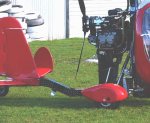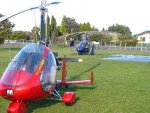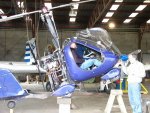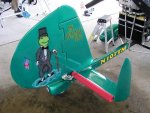This problem is avoidable!
This problem is avoidable!
My Condolences too! We need to fix this problem!
I believe that buntovers (including PPO) can be designed out of gyros!
The gyro needs to be flight tested to see if it is truly statically stable AND buntover proof.
Please conduct the static stability flight tests on your gyro. Know where it is safe to operate and where it is not safe. The THREE static stability flight tests have been published in Rotorcraft magazine and are available at:
https://www.magnigyro.com/USA/features.htm. The three tests are outlined on Parts 3, 4 and 5. (But, please get familiar with the techniques and aerodynamics in all 6 parts!)
There is much talk about static stability. The flight tests describe three different static stability tests. They all are important. But
G-Load static stability is the important issue with buntovers (including PPO).
No one can tell you from just looking at it, or even measuring things on it, if your particular gyro configuration is buntover proof. But, the G-Load static stability flight test can tell you in a few minutes! Test it - it is safe and easy and very quick! Then you will know. You will also find out what flight envelope (power / airspeed/ loading) is safe, and what conditions you should avoid!
G-Load static Stability: If an aircraft is G-Load stable at a specific flight condition (power / airspeed / load), it
WILL NOT be capable of a buntover (including PPO). In the flight conditions where an aircraft is statically G-Load stable, it cannot buntover (or PPO) because for any G-Load disturbance the aircraft will automatically pitch appropriately in the right direction to correct for the G-Load disturbance. When any aircraft is G-Load unstable, that means that a G-Load disturbance from 1G will automatically become worse - like the yardstick balanced on your finger as Udi describes.
So, all you really have to do is test you gryo to be G-Load stable - over the full range and combination of airspeed, power, and loading.
How to test: Simply set the trim for an airsped in s & L flight. Then roll into about a 30 degree bank and verify that you need to pull aft on the stick in order to maintain the original "trimmed" S & L airspeed. That proves that when the aircraft is presented with a G-Load disturbance, as in the banked turn, the aircraft is trying automatically trying to pitch in order to restore to 1 G.
Now, you do need to test this over the full range of combinations of airspeed, power and loading. This is because your gyro may be G-Load stable under the condition of speed or propwash on the HS, but the HS may not be adequate at some other combination of airspeed and power. Doing this full test at one load over the full combination range of airspeed and power should take about 10 minutes! Is 10 minutes of your time worth knowing for sure? Find out for sure, then you will know.
If you don't test for static stability at a certain combination of airspeed and power, then simply consider that combination outside you safe envelope until you do test it.
In the case of this accident - likely a low speed, high power combination - this can be safely tested as described above at low airspeed and high power!
The other static stability tests - Power and Airspeed - are also important things to test - test them! This might take another 10 minutes! They will give you insight as to whether your HS is adequate to "balance" your propeller HTL offset - or not! This might indicate your gyro might not be G-Laod stable at higher power levels or airspeeds. Traditionally, these two static stability criteria also make the aircraft easier to fly and learn to fly - airspeed is fairly constant with power levels, and airspeed returns to "trimmed" airspeed upon a disturbance.
But, G-Load static stability is the key to a gyro configuration that will be immune from buntovers (including PPO) - as long as you verify G-Load static stability under the full range of flight conditions:
High Power / High Airspeed
Low Power / High Airspeed
High Power / Low Airspeed
Low Power / Low Airspeed.
Then check this full range at minimum, maximum and middle loading configurations! Sorry, that may take another few flights!
- Thanks, Greg











